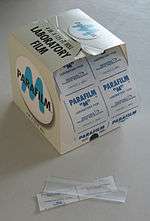Parafilm

Parafilm M(R) is a plastic paraffin film with a paper backing produced by Bemis NA, based in Neenah, WI (United States) primarily used in laboratories. It is commonly used for sealing or protecting vessels (such as flasks or cuvettes). It is a ductile, malleable, waterproof, odorless, translucent and cohesive thermoplastic.
It is also used to further seal a lidded container against moisture and air contamination for long term storage. However it is also claimed that Parafilm M(R) breaks down over time on exposure to air and light and so does not serve as a long-term sealant.
Since it is a thermoplastic, Parafilm M(R) is not safe for use in an autoclave.
Volatile organic solvents will dissolve Parafilm M(R).
Parafilm M(R) is used by some modelers as a masking material during airbrushing, due to its lack of adhesion, which can destroy a finish.
Horticulturalists sometimes use Parafilm(R) Grafting Tape in grafting. Several grafting styles call for wrapping a graft to hold it together, and sealing it to prevent drying and Parafilm(R) Grafting Tape does both. In this context Parafilm(R) is also known as grafting tape.
Entomologists have used Parafilm M(R) as a membrane to feed hematophagous insects such as mosquitoes and bedbugs[1] reared in the lab.
A new application of Parafilm M(R) is to make paper-based microfluidic devices.[2] Paper-based microfluidic devices are considered a suitable way to fabricate low-cost point-of-care diagnostics for developing countries and areas where expensive medical instrumentation is not accessible. Digital microfluidic devices can also use it as the electrode insulator and hydrophobic layer [3]
A similar but now long discontinued product was Sealon film by Fuji.[4][5]
See also
References
- ↑ http://www.nytimes.com/2010/08/31/science/31bedbug.html
- ↑ "Simple and rapid fabrication of paper microfluidic devices utilizing Parafilm® « Chips and Tips". rsc.org.
- ↑ "A two-for-one dielectric and hydrophobic layer for digital microfluidics « Chips and Tips". rsc.org.
- ↑ Mitsuhashi, Jun (1979). "Materials for Artificial Rearing of Leafhoppers". In Maramorosch, Karl & Harris, Kerry F. Leafhopper Vectors and Plant Disease Agents. Academic Press. p. 375.
- ↑ Takahashi, K.; Mogi, I.; Awaji, S.; Watanabe, K. (2011). "Non-contact measurement of diamagnetic susceptibility change by a magnetic levitation technique". Measurement Science and Technology. 22 (3): 035703. doi:10.1088/0957-0233/22/3/035703.